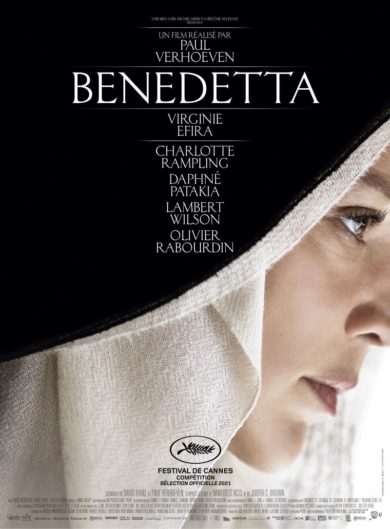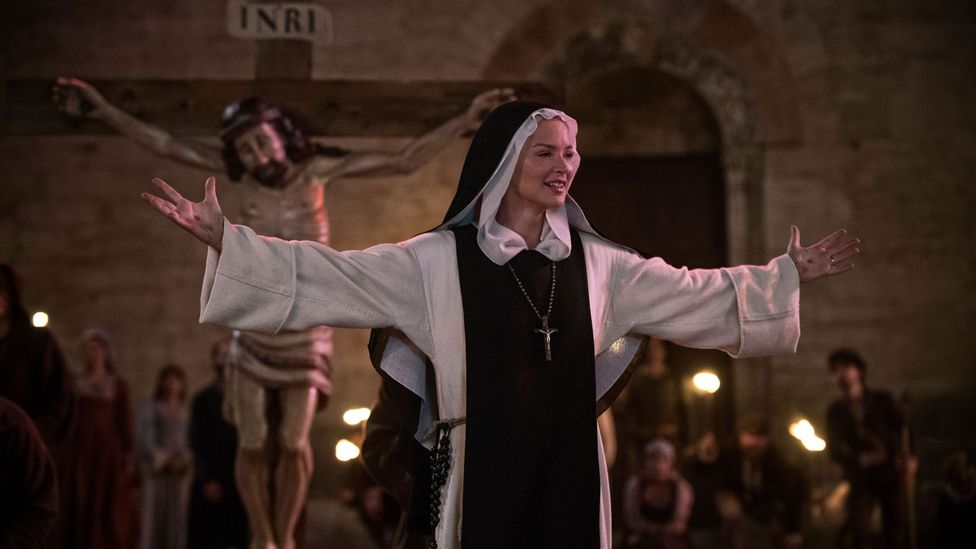 As a Film Comment critic said of the critical reaction to this fact-based nunsploitation film from director Paul Verhoeven, “mileage varies depending on whether it’s taken as a film from the director of ELLE or the man behind SHOWGIRLS.” I say: why not both? Those two extremes are well represented in BENEDETTA, a prestige item that is, conversely, every bit as trashy and exploitive as anyone could desire.
As a Film Comment critic said of the critical reaction to this fact-based nunsploitation film from director Paul Verhoeven, “mileage varies depending on whether it’s taken as a film from the director of ELLE or the man behind SHOWGIRLS.” I say: why not both? Those two extremes are well represented in BENEDETTA, a prestige item that is, conversely, every bit as trashy and exploitive as anyone could desire.
“mileage varies depending on whether it’s taken as a film from the director of ELLE or the man behind SHOWGIRLS.”
It was also a troubled production whose problems began with the initial screenwriter (and longtime Verhoeven collaborator) Gerard Soeteman departing the project due, he claimed, to Verhoeven’s insistence on “fumbling with genitals” at the expense of the feminist message Soeteman was seeking to impart. Further issues confronting the production included various health problems faced by Verhoeven (then in his late seventies) and the Covid-19 pandemic, resulting in a film that was shot in 2018 but took until 2021 to reach the screen.
Based on the 1986 book IMMODEST ACTS: THE LIFE OF A LESBIAN NUN IN RENAISSANCE ITALY by Judith C. Brown, the film was fictionalized somewhat, starting with a change of scenery: it’s set not in Renaissance Italy but a 17th Century French abbey. The title character is first glimpsed as a little girl who believes she’s been personally blessed by the Virgin Mary. Benedetta’s wealthy father sells her to an abbey where she grows into a very attractive young woman, and where her delusions intensify: she comes to imagine herself the literal bride of Jesus Christ.
The title character is first glimpsed as a little girl who believes she’s been personally blessed by the Virgin Mary.
Benedetta also experiences erotic feelings for Bartolomea, a new, much poorer recruit to the abbey. Benedetta initially assuages those longings through acts of petty torture (such as forcing Bartolomea to stick an arm in boiling water), but when Bartolomea is assigned by Sister Felicita, the stern abbess, to keep watch over Benedetta the gals’ desires boil over. They have lots of sex, enhanced at times by a specially carved Virgin Mary statuette—not realizing that Felicita is spying on them through a hole in the wall of Benedetta’s room.

While this is happening Benedetta’s visions, and the fact that she can seemingly speak in the (very masculine) voice of Jesus, become increasingly well publicized. People from all over come to believe that she’s a saint, and make pilgrimages to the abbey to see her. But there’s trouble in store, in the form of the Bubonic Plague, which has reached Europe, and the fact that Sister Felicita has no plans to keep quiet about Benedetta and Bartolomea’s relationship. Alfonso, an irascible Vatican appointed messenger, is called in to head the ensuing trial, which doesn’t go how anyone expects.
The unexpected is this film’s saving grace. In contrast to past nunsploitation films, Verhoeven doesn’t take a stylized approach (a la THE DEVILS), nor a claustrophobic one (a la LA RELIGIEUSE). In contrast to past nunsploitation films, Verhoeven doesn’t take a stylized approach (a la THE DEVILS), nor a claustrophobic one (a la LA RELIGIEUSE). Rather, he’s created an exploitation epic on the order of BEATRICE CENCI (1969) and FLAVIA THE HERETIC (1974), complete with pointed jabs at the hypocritical puritanism imposed by the Catholic Church.
In contrast to past nunsploitation films, Verhoeven doesn’t take a stylized approach (a la THE DEVILS), nor a claustrophobic one (a la LA RELIGIEUSE).

Lacking is the kinetic energy of Verhoeven’s Hollywood fare (of which SHOWGIRLS is a prime example), and also his early Dutch films. What isn’t lacking is the melodramatic edge and dark humor of most all Verhoeven’s work, as is evident in the CGI riddled hallucination sequences, which include the sight of Benedetta having sex with a hermaphrodite Jesus and the latter turning into a most unlikely sword-wielding action hero. That’s in addition to a scene in which one of the protagonists is shown sitting on the toilet to the accompaniment of fart sounds and enough bloodletting to fill a Lucio Fulci movie, proving that Verhoeven’s career-long love of shock and outrage remain at full capacity.
The film’s true saving grace is Virginie Efira in the title role. She may be around two decades too old to play a character who’s supposed to be in her early twenties, and might not galvanize the proceedings in the manner of previous Verhoeven leads like Rutger Hauer in TURKISH DELIGHT, Jeroen Krabbe in THE 4th MAN and Sharon Stone in BASIC INSTINCT, but Efira does anchor the film quite strongly, and is ably supported by Daphne Patakia as her lover and (especially) Charlotte Rampling as Sister Felicita, whose world-weary gaze and slyly impish demeanor are as just upsettling in their way as the sex and violence.
Vital Statistics
BENEDETTA
SBS Productions/Pathe
Director: Paul Verhoeven
Producers: Said Ben Said, Michel Merkt, Jerome Seydoux
Screenplay: David Birke, Paul Verhoeven
(Based on a book by Judith C. Brown)
Cinematography: Jeanne Lapoirie
Editing: Job Ter Burg
Cast: Virginie Efira, Charlotte Rampling, Daphne Patakia, Lambert Wilson, Olivier Rabourdin, Louise Chevillotte, Herve Pierre, Clotilde Courau, David Clavel, Guilaine Londez, Gaelle Jeantet, Justine Bachelet, Lauriane Riquet, Elena Plonka, Heloise Bresc, Jonathan Couzinie, Vinciane Millereau, Jerome Chappatte, Erwan Ribard, Nicolas Beguinot
